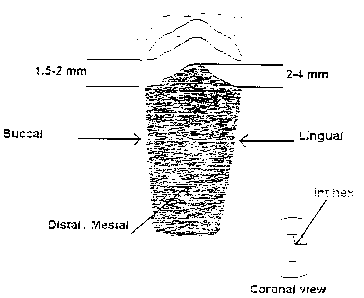Une partie des informations de ce site Web a été fournie par des sources externes. Le gouvernement du Canada n'assume aucune responsabilité concernant la précision, l'actualité ou la fiabilité des informations fournies par les sources externes. Les utilisateurs qui désirent employer cette information devraient consulter directement la source des informations. Le contenu fourni par les sources externes n'est pas assujetti aux exigences sur les langues officielles, la protection des renseignements personnels et l'accessibilité.
L'apparition de différences dans le texte et l'image des Revendications et de l'Abrégé dépend du moment auquel le document est publié. Les textes des Revendications et de l'Abrégé sont affichés :
| (12) Demande de brevet: | (11) CA 2353051 |
|---|---|
| (54) Titre français: | IMPLANT POUR UTILISATION DANS LES REGIONS ESTHETIQUES DE LA BOUCHE |
| (54) Titre anglais: | IMPLANT FOR USE IN AESTHETIC REGIONS OF THE MOUTH |
| Statut: | Réputée abandonnée et au-delà du délai pour le rétablissement - en attente de la réponse à l’avis de communication rejetée |
| (51) Classification internationale des brevets (CIB): |
|
|---|---|
| (72) Inventeurs : |
|
| (73) Titulaires : |
|
| (71) Demandeurs : |
|
| (74) Agent: | RICHES, MCKENZIE & HERBERT LLP |
| (74) Co-agent: | |
| (45) Délivré: | |
| (22) Date de dépôt: | 2001-07-12 |
| (41) Mise à la disponibilité du public: | 2003-01-12 |
| Licence disponible: | S.O. |
| Cédé au domaine public: | S.O. |
| (25) Langue des documents déposés: | Anglais |
| Traité de coopération en matière de brevets (PCT): | Non |
|---|
| (30) Données de priorité de la demande: | S.O. |
|---|
An implant includes an implantable body portion adapted to be at least
partially recessed within a patient's alveolar bone, and which has a
peripheral surface portion which is configured to stimulate and/or facilitate
the engagement of osteoblasts and other bone tissues with the implant.
The implant body provides porous coated bone engaging regions along the
distal and mesial implant sides which axe elongated relative to regions on the
lingual and/or buccal surfaces of the implant body. The porous coating has
a contour selected to generally follow a crestal outline of the supporting
bone tissue.
Note : Les revendications sont présentées dans la langue officielle dans laquelle elles ont été soumises.
Note : Les descriptions sont présentées dans la langue officielle dans laquelle elles ont été soumises.

2024-08-01 : Dans le cadre de la transition vers les Brevets de nouvelle génération (BNG), la base de données sur les brevets canadiens (BDBC) contient désormais un Historique d'événement plus détaillé, qui reproduit le Journal des événements de notre nouvelle solution interne.
Veuillez noter que les événements débutant par « Inactive : » se réfèrent à des événements qui ne sont plus utilisés dans notre nouvelle solution interne.
Pour une meilleure compréhension de l'état de la demande ou brevet qui figure sur cette page, la rubrique Mise en garde , et les descriptions de Brevet , Historique d'événement , Taxes périodiques et Historique des paiements devraient être consultées.
| Description | Date |
|---|---|
| Demande non rétablie avant l'échéance | 2007-07-12 |
| Inactive : Morte - RE jamais faite | 2007-07-12 |
| Inactive : Lettre officielle | 2006-11-27 |
| Inactive : Paiement correctif - art.78.6 Loi | 2006-11-16 |
| Inactive : Abandon.-RE+surtaxe impayées-Corr envoyée | 2006-07-12 |
| Inactive : CIB de MCD | 2006-03-12 |
| Inactive : CIB de MCD | 2006-03-12 |
| Inactive : CIB de MCD | 2006-03-12 |
| Inactive : Grandeur de l'entité changée | 2003-07-31 |
| Inactive : Page couverture publiée | 2003-01-12 |
| Demande publiée (accessible au public) | 2003-01-12 |
| Inactive : Correspondance - Formalités | 2002-10-11 |
| Lettre envoyée | 2002-06-26 |
| Inactive : Transfert individuel | 2002-05-06 |
| Inactive : CIB en 1re position | 2001-08-30 |
| Inactive : Certificat de dépôt - Sans RE (Anglais) | 2001-08-07 |
| Demande reçue - nationale ordinaire | 2001-08-07 |
Il n'y a pas d'historique d'abandonnement
Le dernier paiement a été reçu le 2007-06-26
Avis : Si le paiement en totalité n'a pas été reçu au plus tard à la date indiquée, une taxe supplémentaire peut être imposée, soit une des taxes suivantes :
Les taxes sur les brevets sont ajustées au 1er janvier de chaque année. Les montants ci-dessus sont les montants actuels s'ils sont reçus au plus tard le 31 décembre de l'année en cours.
Veuillez vous référer à la page web des
taxes sur les brevets
de l'OPIC pour voir tous les montants actuels des taxes.
| Type de taxes | Anniversaire | Échéance | Date payée |
|---|---|---|---|
| Taxe pour le dépôt - petite | 2001-07-12 | ||
| Enregistrement d'un document | 2002-05-06 | ||
| TM (demande, 2e anniv.) - générale | 02 | 2003-07-14 | 2003-07-10 |
| TM (demande, 3e anniv.) - générale | 03 | 2004-07-12 | 2004-05-25 |
| TM (demande, 4e anniv.) - générale | 04 | 2005-07-12 | 2005-06-23 |
| TM (demande, 5e anniv.) - générale | 05 | 2006-07-12 | 2006-06-27 |
| 2006-11-16 | |||
| TM (demande, 6e anniv.) - générale | 06 | 2007-07-12 | 2007-06-26 |
Les titulaires actuels et antérieures au dossier sont affichés en ordre alphabétique.
| Titulaires actuels au dossier |
|---|
| INNOVA CORP. |
| Titulaires antérieures au dossier |
|---|
| AVI SHELEMAY |